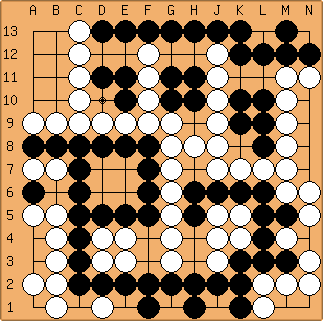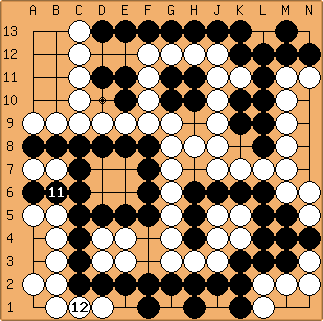Most go literature is not too clear about when to end a ko fight. You read that if the ko threat is bigger than the ko, you should answer the ko threat and continue the ko fight. This implies that if the ko threat is smaller than the ko, you should ignore the ko threat and end the ko fight. This is wrong, this will cost you several points.
See the problem below, figure out the sequence that wins for Black. There are no captured stones, there is no komi (komi = 0).
The only winning sequence is shown below,
followed by the closing moves.
So, the first ko threat already is smaller than the ko, but if Black would have ignored it, he would have lost by 1 point.
There happens to be a rule that easiest makes sense when, quite naturally, the ko threats are played in decreasing order. One should end the ko fight if the sum of the values of the current opponent's ko threat and the next own ko threat is smaller than the sum of the values of the ko and sente after the ko fight.
The value of the ko is 15 points, the value of sente after the ko is 3 points, together 18 points. The value of the ko threat Black ignored is 9 points, the value of the next ko threat is 8 points, together 17 points. So Black ignored White's ko threat for good reason according to the rule, here it happened to be the only way in which he could win.
In a normal game it is difficult to calculate some of the values, but prolonging the ko fight a bit longer usually is a good idea. You see this when replaying pro games, the pro's may not know about the rule but they apparently have an excellent feel for the score.
Kind regards,
Paul




Here follows a mathematical proof of the rule for when to end a ko fight.
Suppose player Black (B) and player White (W).
When Black ends the ko he gains KB points from Black’s point of view. When White ends the ko he gains KW points from White’s point of view. K, the value of the ko, is KB + KW.
When Black gains sente after the ko fight, he gains SB points from Black’s point of view. When White gains sente after the ko fight, he gains SW points from White’s point of view. S, the value of sente, is SB + SW.
The next ko threat of Black has the value of TB points from Black’s point of view. The next ko threat of White has the value of TW points from White’s point of view.
The player who ends the ko fight gains his value of the ko, loses the value of the opponent’s ko threat, but gains his value of the subsequent sente.
When Black ends the ko fight he gets: KB – TW + SB points from Black’s point of view.
When White ends the ko fight at his turn, after Black decided to continue the ko fight, he gets: KW – TB + SW points from White’s point of view, that is:
– KW + TB – SW points from Black’s point of view.
A player should only end the ko fight if the result is better than when the opponent ends the ko fight at the next opportunity. To end the ko fight, Black has to find out whether:
KB – TW + SB > – KW + TB – SW. That is, whether:
KB + KW + SB + SW > TB + TW. That is, whether:
TW + TB < K + S.
Stated in words: one should end the ko fight if the sum of the values of the current opponent's ko threat and the next own ko threat is smaller than the sum of the values of the ko and sente after the ko.
In the above problem the values are:
The ko: KB = 13, KW = 2. The value of the ko is: K = 15.
Sente after the ko fight, two moves, biggest played first: SB = 4, SW = –1. The value of the sente is: S = 3.
White has three ko threats: TW,1 = 11, TW,2 = 9, TW,3 = 7. Black has two ko threats: TB,1 = 10, TB,2 = 8.
Kind regards,
Paul
nice analysis, but I think things get much more complicated when there are multiple kos on the board, though I'm not sure. (which threats do you use for which ko)
The objective of this article was to show the basic truth of a ko fight, by simplifying everything to the core: the values of the ko itself and the ko threats, and most of all the value of sente, that plays a crucial role in the evaluation.
The ko fight is a battle within a battle, having its place after bigger issues and before smaller issues. Where it belongs in the order of things is indeed quite difficult to decide. Once in the ko fight it is important to appreciate the notion that one should prolong a ko fight a bit longer than seems usual even under some professionals (I once read something like "he ended the ko fight in a manly way, there and then").
A practical but not very accurate way to guess the value of sente is to look for the biggest gote move and take half of its value as the value of sente. The idea behind it is that sente moves go the way they have to go to those having sente. The gote moves go alternately to each player. Under special conditions the value of sente is 0, but half the value of the biggest gote move is a reasonable guess, better than no guess at all. Suppose the remaining gote moves have the values of 8, 7, 5, 5, 3, 2, 1 points. The player going first gets 8+5+3+1=17 points, the one going second gets 7+5+2=14 points, here the value of sente is 3 points. Taking the half of 8 as the value of sente is one point off here.
So, how difficult circumstances may be, the mechanism behind the ko fight is clear. Adding complications like multiple ko's, x-steps ko's are beyond what I could proof, but for normal ko's, that is probably more than 90% of ko-like situations, my analysis stands, and you can benefit from it by just remembering not to end the ko fight too early.
Kind regards,
Paul
so difficult but your explanations is good , thank you
I'm not familiar with the mathematical proof of the rule for when to end a ko fight. I just count the position and count the whole board to check if it's enough. It might be harder and longer to check so I will try your way.
Thank you